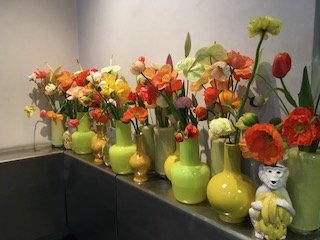Yellow Dots
I went to Vienna in search of a flower shop.
Several years ago, I read an article in The New York Times Sunday Magazine about a flower shop in Vienna. Actually, it was an article about a book by Leonard Koren called The Flower Shop. It described a small business that had taken the ideals of handcraft to a new level, a sort of bespoke flower shop if you will. According to the article, every floral order that this shop created –no matter how small or insignificant—was individually designed and carefully packaged. Koren wrote about how the small staff of florists would give every person walking into the shop time and attention; how even a young child wanting to buy a single bloom for his mother would be treated with generosity and kindness: the flower wrapped in tissue and tied with a bow and then the young customer walked to the door. It wasn’t just that the floral products produced by this shop were unique and wonderful, the service and kindness to the public was equally bespoke and handmade.
I loved everything about this.
Immediately, I ordered the book. In the years since, when my own work and practices need a booster shot of inspiration, I return to the small volume for a chiropractic adjustment of perspective. Basically, I want a bespoke life.
I’ve been thinking a lot of about the ideas of craft, and arts and their intersection with the discipline of practice since returning home from Europe. Specifically, I’ve been thinking about it since visiting the Matthias Church in Budapest. I think it was 10,000th yellow dot painted on one of the many arches inside that really got me thinking. Somebody, or rather a lot of somebodies, painted every one of those yellow stenciled dots. There was a time Europe was employing a lot of artists to build and then to decorate their cathedrals. There were sculptors like Pisano and Donatello who left their marks on figures, pulpits and other marbled reliefs inside such structures. There were artists like Giotto and Michelangelo who painted frescos in the chapels or designed mosaics on the facades or murals on the ceilings, artists who were famous and renowned and sought after.
And then there were the guys painting the yellow dots. Craftsmen.
For the yellow dot is not a creative act. At least, not the 10,000th yellow dot. Painting the 10,001st yellow dot is simply craft. It requires skill and patience and a repetitive attention to detail. Perhaps this was the job given to the apprentices, people who might later go on to create frescos and ceilings and facades. Or it is equally possible that those on the yellow dot shift had little ambitions beyond their circle of influence. Perhaps they were content being a small piece of a grand creative act beyond their scope and often their lifespan. After all, they had steady, meaningful work. It could have very well been enough.
It is too easy to underplay the importance of craft in the practice of any art form. But the truth is that most of the work I do at the piano is craft, plain and simple. I practice scales and arpeggios. I tear music apart one hand at a time and repeat phrases or thorny passages again and again. I inch up tempos with the metronome ticking incessantly in my ear. I am perfecting my skills at painting yellow dots, over and over and over again. That these same yellow dots might become part of a musical masterpiece is the hope, of course. But day after day, they are still yellow dots needing my attention. Practice is craft.
Which is why I had to make a sacred pilgrimage to the flower shop. Blumenkraft (“Flower Power”) is located in the fourth district of Vienna on a quiet side street. It is austere and spare with floor-to-ceiling windows and concrete floors. Bunches of flowers separated by type stand in tall containers on shelves and tables and in the windowsills: bundles of poppies and roses and branches of forsythia.
Blumenkraft, it seems to me, is the practical intersection of art and craft and practice. The attention to detail and creativity and care given to every person, every order, every flower (every yellow dot) is art and craft and practice as one. In a mass-produced, franchised world, it reminds us that there is meaning in the doing.
There was only a single florist at work when I walked in the shop and no other customers on that Saturday morning. I recognized her from the book as the owner. “Can I help you?” she asked. “I read the book . . .” I said. She smiled. “Feel free to look around,” she said, and went back to her worktable.
A month later back at home and in the studio, there are pages and pages and pages of notes needing to be learned. There are 26 students needing lessons and new assignments and practice tips and encouragement after a long winter break. There is a garden needing pruning and planting. There is an almost-finished needlepoint project lying on the rocking chair in corner. There are emails to attend to and errands to run. There are plants to be watered and laps to be swam. All of it demanding time and attention, care and listening, art, craft and practice.
Yellow dots.
